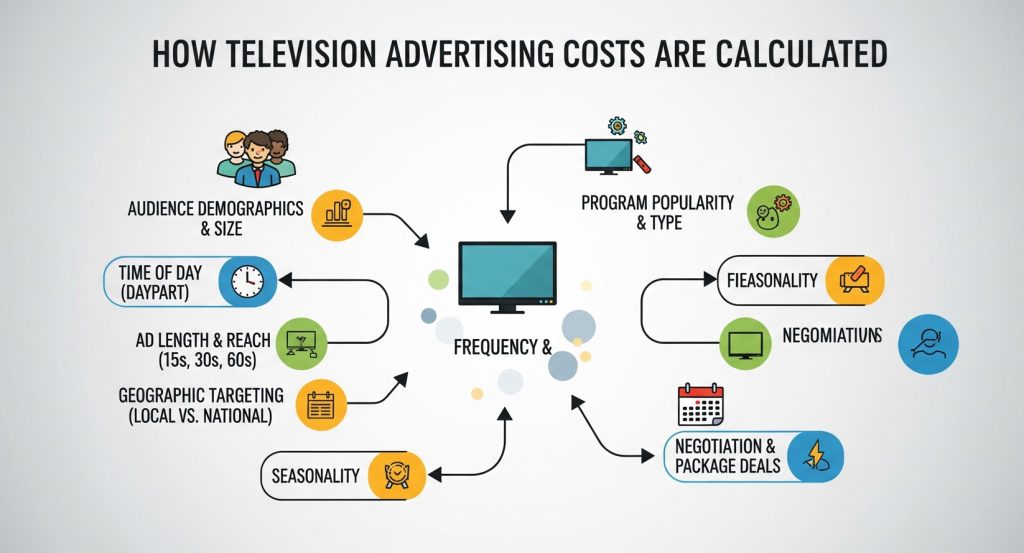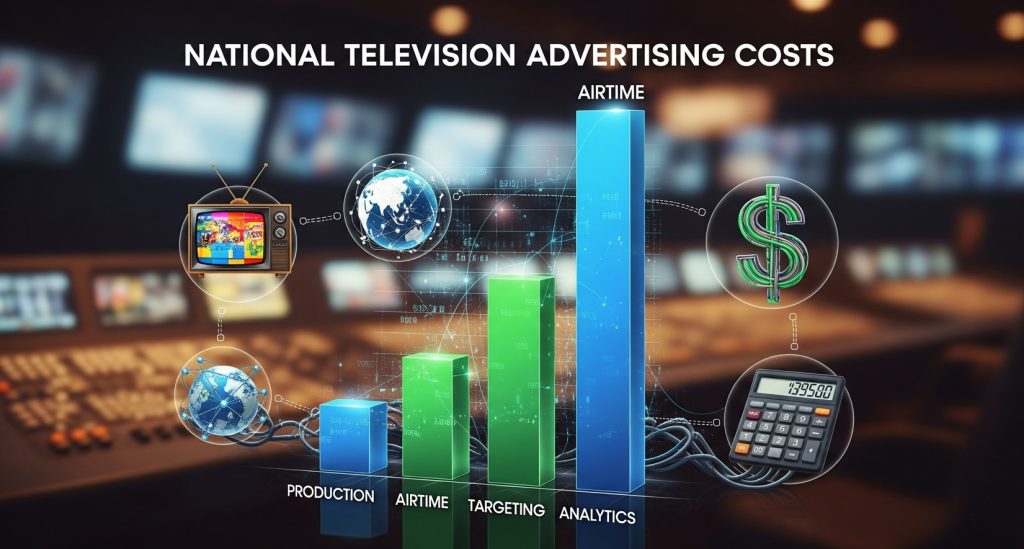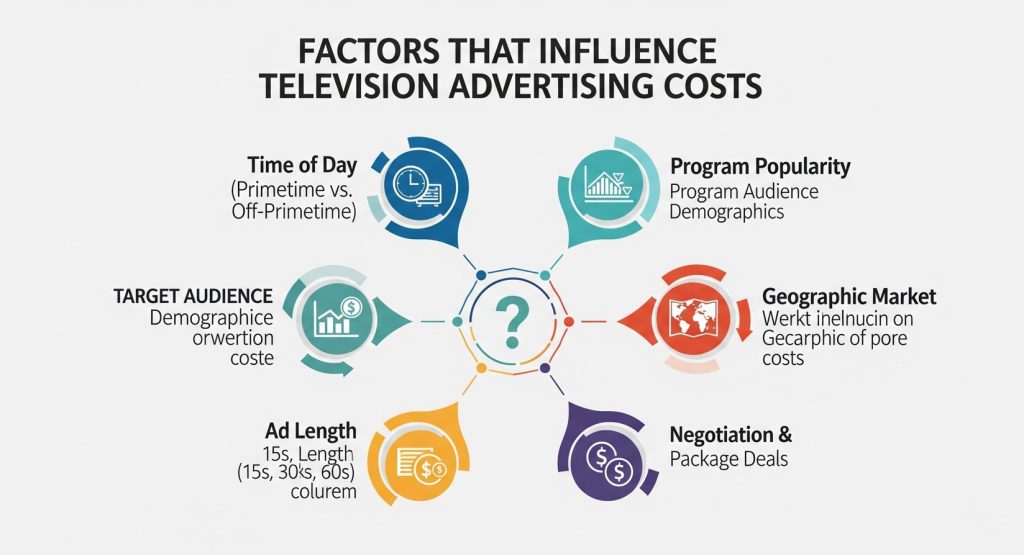Television advertising remains one of the most powerful ways to reach mass audiences, but understanding the costs can feel overwhelming. From prime-time slots that command premium prices to local cable spots that fit smaller budgets, television advertising costs vary dramatically based on multiple factors.
Whether you’re a small business owner exploring your first TV campaign or a marketing professional building a comprehensive media strategy, knowing what to expect from television advertising costs helps you make informed decisions and maximize your return on investment.
This guide breaks down everything you need to know about TV advertising expenses, from national network rates to local market pricing, so you can determine if television advertising fits your marketing budget and goals.
How Television Advertising Costs Are Calculated
Television advertising costs operate on a cost-per-thousand (CPM) model, where advertisers pay for every 1,000 viewers who see their commercial. However, the final price depends on several interconnected factors that can significantly impact your overall investment.

Audience Size and Demographics
The number of people watching a program directly influences pricing. Shows with larger audiences command higher rates, but advertisers also pay premiums for specific demographic groups. For example, reaching adults aged 25-54 typically costs more than targeting broader age ranges because this group represents key decision-makers with disposable income.
Time Slots and Programming
Prime-time television slots (8-11 PM) generate the highest costs due to maximum viewership. Morning shows, late-night programming, and daytime slots offer more affordable options with smaller but often highly engaged audiences. Sports programming and special events can command premium pricing regardless of time slot.
Geographic Reach
National television advertising reaches millions of viewers across the entire country, while local and regional campaigns target specific markets. Local advertising typically costs less per spot but may require multiple markets to achieve desired reach, which can add up quickly.
National Television Advertising Costs
National television advertising represents the highest tier of TV marketing, with costs reflecting the massive audience reach and production quality expected at this level.

Major Network Pricing
The big four networks—ABC, CBS, NBC, and FOX—charge premium rates for their prime-time programming. A 30-second national commercial during popular shows can range from $100,000 to $500,000, with top-rated programs commanding even higher prices.
Cable networks generally offer more affordable national advertising options, with costs ranging from $5,000 to $50,000 for a 30-second spot, depending on the channel’s popularity and target demographics.
Special Events and Premium Content
Major sporting events like the Super Bowl represent the pinnacle of television advertising costs. A single 30-second Super Bowl commercial can cost over $7 million, not including production expenses. Other premium events like the Olympics, World Series, or season finales of popular shows also command elevated pricing.
Award shows, holiday specials, and breaking news coverage can see temporary price increases due to higher-than-expected viewership and advertiser demand.
Local Television Advertising Costs
Local television advertising offers more accessible pricing for businesses targeting specific geographic markets, making it an attractive option for regional companies and franchises.
Market Size Impact
Television advertising costs in local markets vary significantly based on population size and economic factors. Major markets like New York, Los Angeles, and Chicago charge higher rates due to larger audiences and increased advertiser competition.
Small and medium markets offer more affordable entry points, with 30-second spots potentially costing anywhere from $200 to $5,000, depending on the time slot and program popularity.
Local Programming Advantages
Local news programs often provide excellent value for television advertising because they generate consistent, engaged audiences. Morning and evening news slots typically offer reasonable rates while reaching viewers during key decision-making times of day.
Local sports broadcasts, community programming, and syndicated shows can provide targeted audience access at more manageable price points than national alternatives.
Factors That Influence Television Advertising Costs
Several key variables determine the final price you’ll pay for television advertising, and understanding these factors helps you optimize your media buying strategy.

Seasonal Demand Fluctuations
Television advertising costs fluctuate throughout the year based on advertiser demand. The fourth quarter (October-December) typically sees the highest prices due to holiday shopping campaigns, while first and third quarters often offer more favorable rates.
Back-to-school periods, summer vacation seasons, and major retail holidays can create temporary price increases in relevant market segments.
Production Quality Requirements
Beyond media placement costs, television advertising requires significant production investment. Professional commercial production can range from $10,000 for basic local spots to several million dollars for high-end national campaigns.
Production costs include scripting, talent, filming, editing, music licensing, and post-production work. Many advertisers overlook these expenses when budgeting for television campaigns, leading to cost overruns.
Frequency and Flight Duration
Television advertising effectiveness often depends on repetition, but increased frequency drives up total costs. Media planners must balance reach and frequency to maximize impact while staying within budget constraints.
Campaign duration also affects pricing, with longer flights potentially qualifying for volume discounts while shorter, intense bursts might command premium rates.
Alternative Television Advertising Options
Traditional television advertising isn’t the only way to reach TV audiences, and emerging alternatives can offer cost-effective solutions for various marketing objectives.
Connected TV and Streaming Platforms
Connected TV advertising allows precise targeting and often costs less than traditional television while reaching cord-cutting audiences. Streaming platforms offer various advertising models, from pre-roll spots to sponsored content integration.
These platforms typically use different pricing models, such as cost-per-view or cost-per-completion, which can provide more predictable budgeting than traditional CPM models.
Cable and Satellite Options
Cable and satellite providers offer local insertion opportunities that can reduce costs while maintaining broad reach within specific markets. These options often include package deals combining multiple channels and time slots.
Regional sports networks, specialty channels, and cable bundles can provide targeted audience access at more affordable rates than major network programming.
Getting the Most Value from Television Advertising
Maximizing your television advertising investment requires strategic planning, careful negotiation, and ongoing optimization based on performance data.
Media Buying Best Practices
Working with experienced media buyers can significantly impact your television advertising costs through industry relationships, market knowledge, and negotiation expertise. Professional buyers often secure better rates and added value opportunities that individual advertisers cannot access.
Consider package deals that combine multiple time slots, shows, or even different media types to reduce overall costs while increasing campaign reach and frequency.
Measuring Return on Investment
Television advertising success requires robust measurement strategies that track both immediate response and long-term brand impact. Direct response metrics, website traffic analysis, and brand awareness studies help justify television advertising expenses and optimize future campaigns.
Attribution modeling becomes crucial when television advertising works alongside digital marketing efforts, ensuring you accurately measure each channel’s contribution to your business goals.
Making Television Advertising Work for Your Budget
Television advertising costs vary tremendously, but opportunities exist for businesses of all sizes to leverage this powerful medium effectively.
Start by clearly defining your target audience and geographic needs, then explore local options before considering regional or national campaigns. Many successful television advertisers begin with local markets to test messaging and creative approaches before expanding their reach.
Consider working with experienced media professionals who can help navigate the complex television advertising landscape and secure the best possible rates for your specific needs. The right strategy can make television advertising an affordable and highly effective component of your marketing mix.
Remember that television advertising costs represent just one part of your total investment—factor in production expenses, campaign management, and measurement tools when building your budget. With careful planning and strategic execution, television advertising can deliver exceptional results that justify the investment and drive meaningful business growth.





